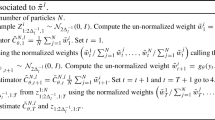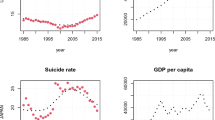Abstract
Brownian motion whose infinitesimal variance changes according to a three-state continuous-time Markov Chain is studied. This Markov Chain can be viewed as a telegraph process with one on state and two off states. We first derive the distribution of occupation time of the on state. Then the result is used to develop a likelihood estimation procedure when the stochastic process at hand is observed at discrete, possibly irregularly spaced time points. The likelihood function is evaluated with the forward algorithm in the general framework of hidden Markov models. The analytic results are confirmed with simulation studies. The estimation procedure is applied to analyze the position data from a mountain lion.
Similar content being viewed by others
References
Bshouty D, Di Crescenzo A, Martinucci B, Zacks S (2012) Generalized telegraph process with random delays. J Appl Probab 49:850–865
Cappé O, Moulines E, Rydén T (2005) Inference in Hidden Markov Models. Springer, Berlin
Codling EA, Plank MJ, Benhamou S (2008) Random walk models in biology. Journal of The Royal Society Interface 5:813–834
De Gregorio A, Iacus SM (2008) Parametric estimation for the standard and geometric telegraph process observed at discrete times. Stat Infer Stoch Process 11:249–263
De Gregorio A, Iacus SM (2011) Least-squares change-point estimation for the telegraph process observed at discrete times. Statistics 45:349–359
Di Crescenzo A (2001) On random motions with velocities alternating at Erlang-distributed random times. Adv Appl Probab 33:690–701
Di Crescenzo A, Pellerey F (2002) On prices’ evolutions based on geometric telegrapher’s process. Appl Stoch Model Bus Ind 18:171–184
Di Crescenzo A, Martinucci B, Zacks S (2014) On the geometric brownian motion with alternating trend. In: Perna C, Sibillo M (eds) Mathematical and Statistical Methods for Actuarial Sciences and Finance. Springer, Dordrecht, pp 81–85
Di Crescenzo A, Zacks S (2015) Probability law and flow function of Brownian motion driven by a generalized telegraph process. Methodol Comput Appl Probab 17:761–780
Efron B, Hinkley D (1978) Assessing the accuracy of the maximum likelihood estimator: observed versus expected Fisher information. Biometrika 65:457–487
Efron B, Tibshirani R (1994) An Introduction to the Bootstrap. CRC Press, Boca Raton
Horne JS, Garton EO, Krone SM, Lewis SJ (2007) Analyzing animal movements using Brownian bridges. Ecology 88:2354–2363
Hu C, Pozdnyakov V, Yan J (2019a) coga: Convolution of Gamma Distributions. R package version 1.0.0
Hu C, Pozdnyakov V, Yan J (2019b) Density and distribution evaluation for convolution of independent gamma variables. Computational Statistics. In press
Iacus SM, Yoshida N (2008) Estimation for the discretely observed telegraph process. Teor Ĭmovı̄rnosteı̆ Mat Stat 78:32–42
Kolesnik AD, Ratanov N (2013) Telegraph processes and option pricing. Springer Briefs in Statistics, Springer, Berlin
Lindsay BG (1988) Composite likelihood methods. Contemp Math 80:221–239
Mathai A (1982) The storage capacity of a dam with gamma type inputs. Ann Inst Stat Math 34:591–597
Moschopoulos P (1985) The distribution of the sum of independent gamma random variables. Ann Inst Stat Math 37:541–544
Norris JR (1998) Markov Chains, volume 2 of Cambridge Series in Statistical and Probabilistic Mathematics. Cambridge University Press, Cambridge. Reprint of 1997 original
Othmer HG, Dunbar SR, Alt W (1988) Models of dispersal in biological systems. J Math Biol 26:263–298
Perry D, Stadje W, Zacks S (1999) First-exit times for increasing compound processes. Commun Stat Stoch Mod 15:977–992
Pozdnyakov V, Meyer T, Wang Y-B, Yan J (2014) On modeling animal movements using brownian motion with measurement error. Ecol 95:247–253
Pozdnyakov V, Elbroch L, Labarga A, Meyer T, Yan J (2019) Discretely observed Brownian motion governed by telegraph process: estimation. Methodol Comput Appl Probab 21:907–920
Preisler HK, Ager AA, Johnson BK, Kie JG (2004) Modeling animal movements using stochastic differential equations. Environmetrics 15:643–657
Sericola B (2000) Occupation times in markov processes. Communications in Statistics. Stoch Model 16:479–510
Stadje W, Zacks S (2004) Telegraph processes with random velocities. J Appl Probab 41:665–678
Tilles PFC, Petrovskii SV (2016) How animals move along? exactly solvable model of superdiffusive spread resulting from animal’s decision making. J Math Biol 73:227–55
Viterbi AJ (2006) A personal history of the Viterbi algorithm. IEEE Signal Proc Mag 23:120–142
Yan J, Chen Y-W, Lawrence-Apfel K, Ortega I, Pozdnyakov V, Williams S, Meyer T (2014) A moving-resting process with an embedded Brownian motion for animal movements. Popul Ecol 56:401–415
Yan J, Pozdnyakov V, Hu C (2019) smam: Statistical Modeling of Animal Movements. R package version 0.4.0
Zacks S (2004) Generalized integrated telegraph processes and the distribution of related stopping times. J Appl Probab 41:497–507
Zacks S (2012) Distribution of the total time in a mode of an alternating renewal process with applications. Seq Anal 31:397–408
Zucchini W, MacDonald IL, Langrock R (2016) Hidden Markov Models for Time Series: An Introduction Using R, 2 edn. Chapman and Hall/CRC, London
Author information
Authors and Affiliations
Corresponding author
Additional information
Publisher’s Note
Springer Nature remains neutral with regard to jurisdictional claims in published maps and institutional affiliations.
Rights and permissions
About this article
Cite this article
Pozdnyakov, V., Elbroch, L.M., Hu, C. et al. On Estimation for Brownian Motion Governed by Telegraph Process with Multiple Off States. Methodol Comput Appl Probab 22, 1275–1291 (2020). https://doi.org/10.1007/s11009-020-09774-1
Received:
Revised:
Accepted:
Published:
Issue Date:
DOI: https://doi.org/10.1007/s11009-020-09774-1




